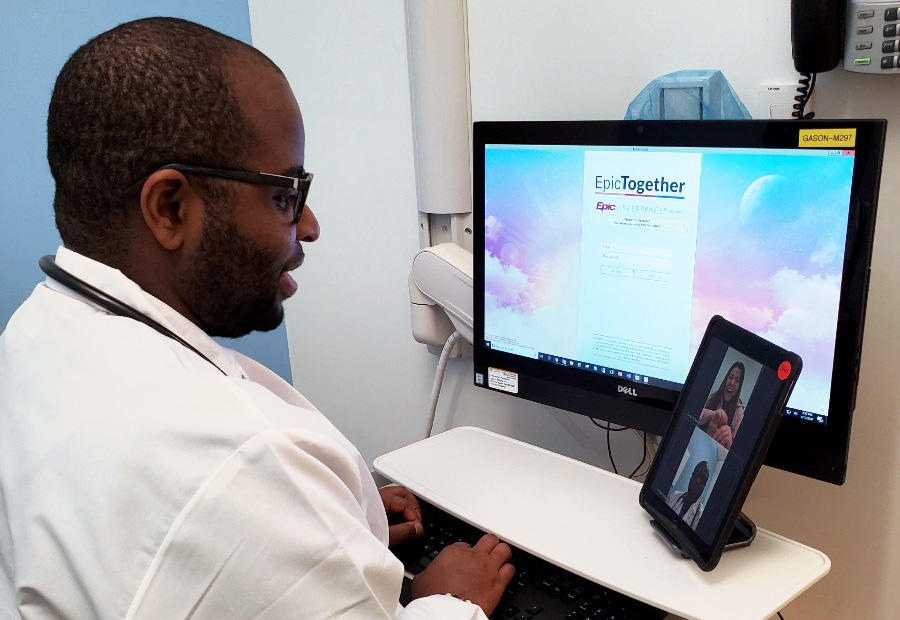The School of Nursing faced an unprecedented dilemma. Normally, as part of its curriculum, nursing students are posted to New York City hospitals, where they work one-on-one with practicing nurses to make the transition from student to nurse. But in March, with COVID-19 spreading throughout the city, hospitals with burgeoning caseloads suspended the student practicums. This was followed by an edict from Columbia University Irving Medical Center (CUIMC) that, for safety’s sake, no student should take care of someone diagnosed with COVID-19.
At first, students were allowed to work in hospitals that had yet to be overrun by the pandemic as long as they weren’t caring for COVID-19 patients. But as more COVID-19 cases were admitted to the hospitals — and as more institutions came to prioritize the health of their employees — the students were turned away.
And so the School of Nursing got creative: anticipating that hospital staff would soon be under stress — they were getting sick, their families were getting sick, they were self-isolating, they were tired — the school offered to send students to hospitals as paid nurse technicians, where they could draw blood, take vital signs, and perform EKGs for non-COVID-19 patients. “It’s less than what a professional nurse does but similar to what students would do under the supervision of a staff person,” says Judy Honig ’77TC, ’05NRS, the School of Nursing’s vice dean of academics and dean of students.
But no sooner had the arrangement been negotiated than the hospitals filled up almost entirely with people infected with COVID-19. Now the school had to make another on-the-fly adjustment: students were advised that they would, in fact, be working with COVID-19 patients. The school informed the students of the risks and emphasized that there was no shame in turning down the assignment: it would be up to them and their families to decide. Out of the 180 students in Columbia’s MS program in nursing, eighty-five signed up to work. They started in April.
Though the arrangement is not part of the academic curriculum, the students are invited to attend weekly online seminars run by faculty and led by Jennifer Dohrn ’05NRS, an associate professor of nursing, to share their experiences. “Working in any capacity in any hospital is a frightening thing right now,” says Honig, and the idea is to give students a chance to relieve anxiety and, ideally, forestall any potential posttraumatic stress. Says Honig, “People rally during a time of crisis, and afterward it hits them.”
In lieu of traditional clinical experience, the nursing school is seeking other ways to keep students engaged. Seventy-six students are participating in CUIMC’s coronavirus hotlines, fielding questions from the public and hospital staff about symptoms, testing, and treatment and allowing hospital personnel to be diverted from the phones to units where their skills are needed. And with city hospitals also desperate for help, the school has deployed eighty students to answer similar questions for the NYC Health and Hospitals COVID-19 hotline. “Call centers are substituting for some of the advance practice that students are missing out on,” says Honig. “It’s an unusual clinical, but it’s keeping them part of the crisis response, which is important. We’re putting technology in place so a lot of our students can do telemedicine — interviewing and assessing patients electronically.”
Telemedicine has become essential for students and faculty alike. At the Nurse Practitioner Group (NPG), the nursing school’s faculty-run clinic, technology is helping professionals manage a crisis unlike any in living memory. “I’ve been a nurse practitioner for twenty years, and I’ve never seen anything like this,” says Stephen Ferrara, the associate dean of clinical affairs at the nursing school and the director of NPG. “In the infectiousness, the severity, the widespread rates, and the measures that we are taking to try to stem the further spread, this pandemic is unlike anything I could have expected.”
The clinic, which consists of ten nurse practitioners, has two locations: one in Midtown and one at CUIMC on 168th Street. NPG serves the local community, typically conducting annual physicals and treating both garden-variety maladies and chronic conditions like high blood pressure and diabetes. In late February the uptown location was converted into a “cough, cold, and fever” clinic, set up to provide onsite assessments of patients with potential coronavirus symptoms and determine if they should be tested. Other patients — including the elderly and those with diabetes, chronic lung disease, and cardiovascular disease, who are at high risk of fatal exposure to coronavirus infection simply by leaving their homes — are being “seen” via computer or telephone.
“It’s hard to examine a patient without being there,” says Ferrara, “but we’re teaching patients how to check their own pulse and take their own temperature and report the results during the visit.” NPG has also taken on the crucial role of electronically following up with the non-COVID-19 patients that CUIMC has released in order to free up beds for those critically stricken with the virus.
The situation has tested both faculty and students, and there is no longer such a thing as business as usual. “We don’t know what the future is going to bring, and it’s hitting everybody,” Honig says.
Even before the pandemic, the courage and resilience of nurses could hardly be overstated. Still, in the face of such uncertainty, you might expect that many who had planned to pursue what is often called the world’s most honorable profession might change direction. Yet of the 244 students slated for this year’s incoming class — courses start this summer — 231 are still planning to attend.
“This was the commitment they made, and they’re looking forward to joining us,” Honig says. “That’s the kind of applicants we have — they just wade right in.”



